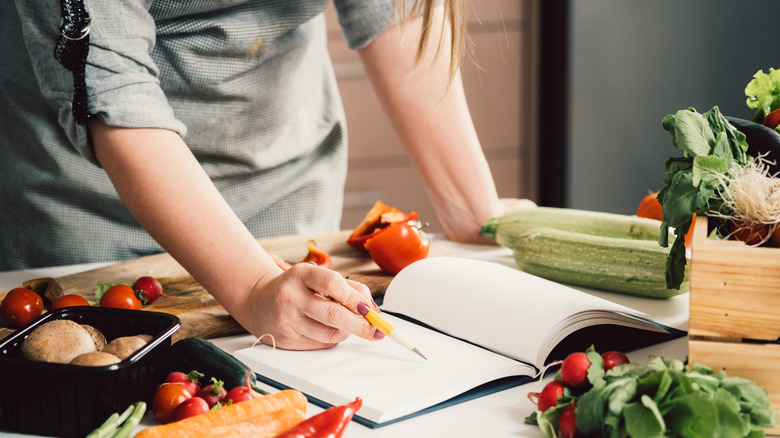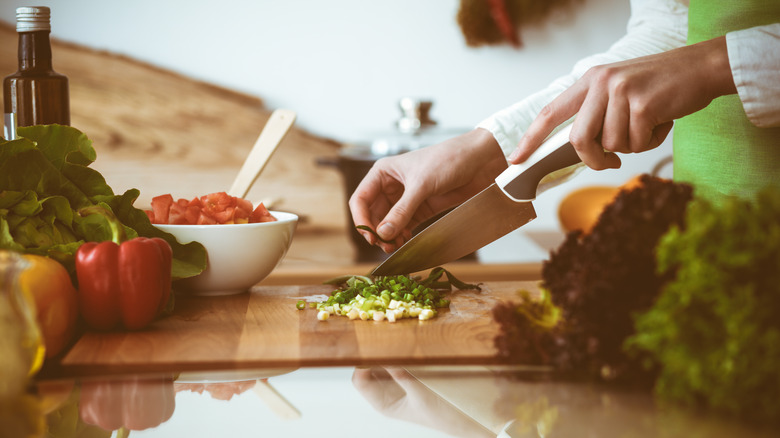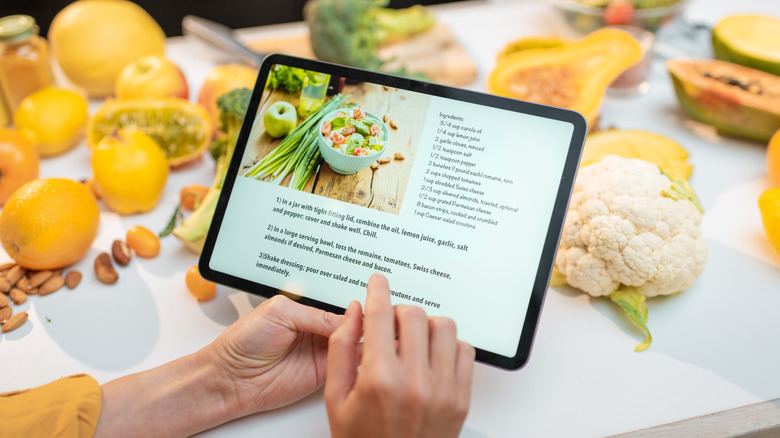What You Need To Know About No-Recipe Cooking
As you may have noticed, we're pretty big fans of cooking over here. From quickie dishes such as three-ingredient cheese biscuits to more involved authentic empanadas, we absolutely love chopping, stirring, baking, sautéing, frying, and grilling up appetizers, main dishes, desserts, and everything in between. But as much as we enjoy following recipes — particularly when we're making something involved such as triple chocolate gluten-free cookies — there are many nights when we just want to wing it in the kitchen. As it turns out, we're not alone: No-recipe cooking, as the name implies, is a more improvisational way of turning out dishes without following a detailed set of instructions. And according to Eater, it's making a comeback lately.
As the article explains, no-recipe cooking was pretty much the way people around the world cooked since forever, even after the advent of modern cookbooks beginning in the mid-1800s. These early cookbooks assumed a high level of knowledge of cooking styles and techniques and gave only the barest outline of how to prepare the "recipes" within. But by the mid-20th century, Eater notes, all that changed. The "modern recipe" — one of precise measurements and detailed instructions — began to take shape and has been all but dominant ever since. Read on to learn more about no-recipe cooking and why it's making a comeback.
No-recipe cooking has a long history
As explained in an article by Eater, no-recipe cooking — the style of cooking with just a bare-bones amount of instruction — has a long history in the United States and around the world. When modern cookbooks became fairly accessible to a variety of home cooks — by the mid-1800s in the U.S. — home cooks, who were typically women preparing meals for their families, tended to be highly skilled and comfortable creating a variety of foods in the kitchen. The very basic style of the recipes in old cookbooks, the article's author Marian Bull writes, "assumed their readers already knew how to cook."
As a result, early published recipes barely gave any instruction at all. A recipe for macaroni published in the 1904 cookbook "Cooking in Old Créole Days" reads, in part, "Macaroni must be thrown into plenty of boiling water to cook it well. Then drain it off and put it in a dish with salt and a little powdered mustard, and put it in the oven until there is a nice crust on top. Grated cheese of any kind may be added."
As you can see, there's not much information there — no cook times, no precise measurements — but most home cooks reading the recipe would have had the know-how to easily throw together the dish. And recently, as cooking enthusiasts are once again becoming quite skilled, there's been a return to no-recipe cooking.
The comeback of no-recipe cooking
According to Eater, the no-recipe style of cookbooks began to change in the mid-20th century as the modern recipe began to take shape. At that time, according to Celia Sack of San Francisco's Omnivore Books, "women suddenly found themselves without kitchen help — help who were raised to cook and not to need delineated recipes — and had no idea how to 'make a batter' or how long to 'bake until done.'"
Home cooks' level of knowledge had dramatically declined, and in response, modern recipes began to delineate everything for them with detailed ingredients lists, exact cooking times, and precise preparation instructions. But over the past few years, as home cooks have devoured cooking shows, recipe blogs, and YouTube cooking videos, the average level of cooking experience is going up again — and a new rash of no-recipe cookbooks reflects that.
Things got going in 2017 with the publication of New York Times writer Samin Nosrat's bestselling cookbook "Salt, Fat, Acid, Heat," whose first recipe doesn't appear until page 217 after the author first outlines the tenets of good cooking and learning flavors. More recently, Sam Sifton, the founding editor of New York Times Cooking, has published "New York Times Cooking: No-Recipe Recipes," which contains recipes with bare-bones ingredient lists and single-paragraph directions. "Cooking without recipes is a kitchen skill," Sifton writes in the book (via Eater). "It's a proficiency to develop, a way to improve your confidence in the kitchen and makes the act of cooking fun."


